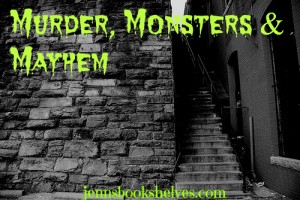For today’s edition of The First Book That Terrified Me, I am pleased to welcome author Matthew Dicks! Matthew is the author of three novels, his most recent being MEMOIRS OF AN IMAGINARY FRIEND, published in the United States in August of 2012. He’s a teacher, parent, DJ and occasional minister and a life coach. Check out his blog! Please join me in welcoming Matthew!
I grew up with very few books in the home. Other than a small collection of bedraggled picture books that my siblings and I eventually converted to drawing paper (which was also in short supply), our bookshelves were bare. And until I was old enough to ride my bike to the public library and begin checking out books on my own, I had never set foot inside its small, dimly lit basement interior.
As a child, getting my hands on a book, any book, was hard for me for a long time.
Despite the absence of books, I loved to read. In school, I went through the entire SRA reading program in under a month and enjoyed it. I would check out the thickest, heaviest books from the school library just so I would have enough material to read until our next library session. I would steal books from my teacher’s desk and take them home to read. One time I accidentally stole the teacher’s edition containing all the answers to our weekly phonics tests. I should’ve been excited about this unexpected find, but I was only annoyed that the book had no real content to read. I was desperate for sentences and stories. I would read cereal boxes, TV Guide, The Woonsocket Call and even the Bible.
Eventually, even this wasn’t enough for me. That was when I turned to my step-father’s bookcase, tucked away in the corner of the den. My step-father was a psychiatric social worker, so the middle two shelves of the bookcase filled with academic tomes related to the fields of psychology and social work: thick, unintelligible texts that made the Bible look like a Dick and Jane primer. But the top shelf was lined with the Funk & Wagnall’s encyclopedia, letters A-M and the bottom shelf contained a small collection of fiction and nonfiction paperbacks.
I started with the encyclopedias, reading each one from cover to cover, and finished off the collection in a few months. Then I turned my attention to the bottom shelf. It contained a total of five books, all well-read and yellowing around the edges. The books were Jaws by Peter Benchley, a book about the Japanese invasion of Wake Island during World War II, a book about the Japanese attack on Pearl Harbor, Breakfast of Champions by Kurt Vonnegut, and .44, a novel by Jimmy Breslin and Dick Schaap based upon the Son of Sam murders in New York City in the late 1970’s.
I started with Jaws and the World War II histories and loved those books immensely. The probably read the book on the Wake Island invasion a dozen times. Then I turned my attention to .44. Though technically a novel, the book is based closely on the events surrounding serial killer David Berkowitz’s New York City murder spree, relying on fiction only to fill in the gaps that history could not do so on its own. At the time, however, I was under the impression that I was reading nonfiction, making the content seem ever more real to me.
 This book terrified me. It was the first book to truly terrify me.
This book terrified me. It was the first book to truly terrify me.
Jaws was certainly frightening, but it was nothing like .44. Unless I was swimming in the open ocean, the monster that Benchley created could not reach me. It was malevolent, but it was restricted to the water. My summer beach days might never be the same, but I did not live with constant fear after reading Benchley’s novel.
But David Berkowitz was an ordinary man from a city not so far away who would sneak up behind his victims while they sat in parked automobiles and blow their brains out. Berkowitz had no restrictions. He had walked through his neighborhood undetected and unimpeded for months before he was caught, despite the fact that he was clearly insane. He was infinitely more terrifying than a great white shark, because he was a predator amongst us. David Berkowitz terrorized a city because he was anyone.
This alone would’ve been terrifying enough for me, but I had even more reason to be frightened.
At the time that I was reading this book, I was also being terrorized by gunmen of my own. For more than two years, the Blackstone Valley snipers were on the loose, shooting high powered rifles through living room windows at darkened silhouettes in our town and the surrounding towns. Until the shooters were captured in 1987, after wounding three victims and firing upon scores more, I was required to crawl through our living room at night and avoid all windows. It was like living in a war zone. We never knew when a bullet might crash through our window and find our head or chest. My parents became so afraid of the snipers that we moved our Christmas tree into the rear of the kitchen for a year in fear of illuminating the living room with its holiday glow.
Reading about David Berkowitz while crawling under picture windows and seeing headlines about the snipers’ latest victims in the newspapers made for a perfect storm in my teenage mind. It made an already terrifying book something much more. It made the story real beyond the page. The book that I was reading and the life that I was leading blended into one terrifying storm.
In my latest novel, Memoirs of an Imaginary Friend, my protagonist, an imaginary friend named Budo, says, “Monsters are bad things, but monsters that do not walk and talk like monsters are the worst.”
I wasn’t thinking about David Berkowitz and the Blackstone Valley snipers when I wrote that sentence, expect that maybe I was. Maybe those ancient fears and distant memories still reside somewhere within my mind, exerting influence that I cannot begin to imagine A monster like Jaws is bad, but at least there is no mistaking the dorsal fin and rows of razor sharp teeth. But Schaap and Breslin’s portrayal of David Berkowitz is terrifying in both its explicit accuracy and especially in the way in which they present him as an ordinary man. David Berkowitz was a man who lived among us, shooting us in the back of the head when the neighbor’s dog demanded it. He wrote letters to law enforcement authorities while committing crime after crime after crime, and still he was not caught.
Despite my fear, I read .44 multiple times when I was young. I needed books to read, and it was available. Even though I haven’t seen the book in almost 30 years, I remember it well. I can still recall the way the chapters were laid out. I can still envision specific scenes from the book with great clarity. The book no longer frightens me as it did so long ago, but just thinking about that opening scene of the novel, in which a young woman is shot and killed by a madman with a gun, sends a shiver down my spine.
For so many years, Dick Schaap and Jimmy Breslin’s combination of fiction and fact kept me awake at night, wondering if I might be the next victim of senseless, random violence. Today we have a new breed of madman, armed with much more than just a .44 caliber handgun, who keeps me awake at night. But for a teenage boy who was already ducking bullets from a pair of long forgotten suburban snipers, .44 was my first introduction into senseless, real world violence. Schaap and Breslin’s words made the shadows a little longer, the night a little darker and the threat of random violence a little more possible to an impressionable mind.
Thank you, Matthew! Be sure to come back on Thursday for yet another edition of The First Book That Terrified You!







4 Responses to #Mx3 Guest Post: The First Book That Terrified Me (.44 by Jimmy Breslin and Dick Schaap)